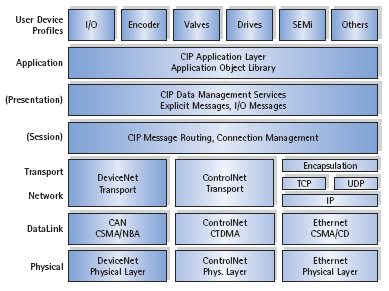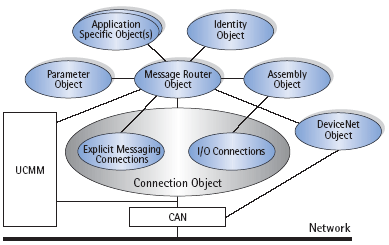DeviceNet is one of three open network standards (DeviceNetTM, ControlNetTM and EtherNet/IPTM), all of which use a common application layer, the "Common Industrial Protocol" (CIPTM). This common application layer and open software and hardware interfaces allow for a universal connection of automation components from the fieldbus level over the control level to the enterprise level.
The Family of CIP Networks is specified and published by ODVA (Open DeviceNet Vendor Association - http://www.odva.org ![]() ) and CI (ControlNet International - http://www.controlnet.org
) and CI (ControlNet International - http://www.controlnet.org ![]() ).
).
The Common Industrial Protocol presents communication and application in the object model. Predefined objects facilitate the data exchange between different devices and manufacturers. By creating various device profiles, additional standardization benefiting the user was achieved.
CIP is a connection based protocol. It defines the exchange of I/O data using I/O Messaging (or Implicit Messaging) as well as the exchange of general data for configuration, diagnostic and management via Explicit Messaging. CIP thus provides 4 essential functions to the user:
- Common object model for application
- Common communication model for data exchange in the network
- Common configuration methods
- Common device profiles
DeviceNet is the implementation of CIP over CAN (Controller Area Network).
The DeviceNet specification standardizes the physical connection of DeviceNet nodes by defining Layer 4, Layer 3 (DeviceNet Transport), Layer 2 (Usage of CAN), Layer 1 and Layer 0 (Physical Layer and Transmission Media). Along with specifying connectors, cable types and cable lengths, communication-based displays, operating elements and the corresponding housing labelling are also defined.
A DeviceNet network can run up to 64 nodes with baud rates of 125, 250 or 500 kBaud. The maximum length of a DeviceNet network can be up to 500 m (at 125 kBaud and usage of suitable cables). The devices can either be supplied via the DeviceNet network (nominal 24 V) or have their own power supply.
The main field of application of DeviceNet is factory automation with I/O-modules, valves, encoders, simple drives and controls (PLC). Within the Family of CIP Networks DeviceNet covers the main part of the applications where small to medium amount of data with short to medium cycle times (1 ms to 500 ms) can be exchanged in the network.
Classic Master/Slave applications are supported by the Predefined Master/Slave Connection Set.
The Unconnected Message Manager Port (UCMM) and the dynamic creation of connections for Explicit Messages and I/O Messages were specified for more complex slave devices and the support of Peer-to-Peer networking.
